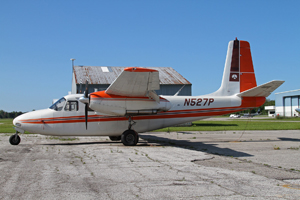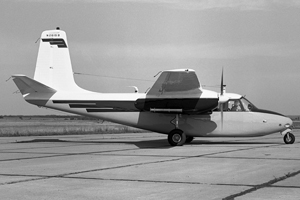LOOKING BACK: THE HISTORY OF THE
TWIN COMMANDER LINE

By Barry Collman

N527P is Model 520 s/n 62. The photo was taken June 7, 2010, at Port Huron, Michigan, by Chris Haag. Since then it's been bought by Twin Commander Flight Group member Adam Frisch and re-registered as N20VE.
The Model 520 was the first Aero Commander to be placed into production by the Aero Design & Engineering Company, based at Tulakes Airport in Bethany just southwest of Oklahoma City. Tulakes Airport was later renamed
Wiley Post Airport.
The 520 production run included 150 aircraft (s/n 520-1 through 520-150) that were built between August 1951 and April 1954. The first one rolled out on August 24, 1951, and the first flight was made three days later. The certification process started on January 9, 1952, and was completed 22 days later on January 31 when the Model 520 was added to Type Certificate 6A1.
Three new 520s were initially certified in 1951, 40 in 1952, 78 in 1953,
and 29 in 1954.
A factory document describes the Model 520, under Wing Drawing 5170000, as first certified on January 31, 1952. It was very similar to the L-3805 except for an increase in gross weight to 5500 pounds from 4600 pounds, and an engine change to the Lycoming GO-435-C2B. In 1954 the gross weight was increased to 5700 pounds, which required some structural changes.
Being the first production model Aero Commander, it is perhaps not too surprising that it evolved more times than any other individual model.
When first flown, s/n 520-1 had Lycoming GO-435-A2 engines. By November 1951 the engines had been changed to the GO-435-C2, and this series was used in all subsequent 520s.
The original vertical fin was not as tall and had a wider chord at the tip than the one that was eventually used. It also had a much larger dorsal fillet, and the horizontal tailplane had a wider span. Also, the vertical fin and rudder each had a separate cap. This arrangement changed--the separate caps were eliminated and the top rib of the vertical fin was extended to support a fixed tip cap back over the end of the rudder. This same principle was also applied to the horizontal tail.
The first 14 520s, plus a couple of later ones, had the non-feathering Hartzell HC-12X20-8C/9333C-3 propellers. Later ones used a "one-shot" feathering propeller, the HC-12X20-9C/9333C-3, whereby the pilot pulled a handle that pulled a pin that allowed the propeller to feather, but it was not possible to
un-feather it in flight.
Hartzell soon developed a fully-feathering propeller, and from s/n 520-39 on, the Hartzell HC82X20-2 series was used. Three earlier examples supplied to the U.S. Army--s/n 520-17, 520-21, and 520-23--also used this propeller. All Model 520s originally had 90-inch-diameter two-blade propellers, but many have subsequently had 84-inch-diameter three-blade Hartzell HC-83X20-2 series hubs installed with 8433-model blades.
The first 18 or so had electric trim systems that used Army surplus actuators, but except for a few more retained for spares this was the total supply, so a new system had to be designed. This was accomplished by Ken Hale, who came up with an overhead cable system that remained basically the same for every Commander subsequently built.
The Model 520 had a gross weight of 5,500 lb, but Aero Commander Service Change No. 26-520, when complied with, allowed an increase to 5,700 lb. It applied to s/n 520-31 through 520-150.
Early examples originally had a single pair of relatively long nose wheel doors. In April 1952 the factory had re-designed this arrangement, which now comprised a pair of short doors and a pair of longer doors aft of them. However, when all of these were open upon gear extension, the high-velocity airflow under the nose created considerable turbulence within the wheel well cavity. Since the wheel well enclosure is essentially a "tin box," the resulting noise and vibrations would have been objectionable to some customers.
So, the next and final arrangement fixed this problem, and it remained essentially unchanged throughout all future production. It sequenced the opening and closing of the doors and was powered by the movement of the gear strut. On landing approach, as the nose gear starts to move on extension, the system opens both pairs of doors. As the gear strut approaches full down, the system then closes the longer aft pair of doors. Upon retraction after takeoff, the system opens the aft pair of doors and as the strut approaches full up, the system then closes both pairs of doors. Aero Commander Service Change No. 7-520, dated August 26, 1952, was issued to enable this system to be applied to 520s built earlier.
The first 30 or so had no emergency exit for the window opposite the cabin door. Note 6 of the Type Certificate Data Sheet exempts those earlier 520s that are below the six- or seven-place configuration from having the emergency exit, but the drawing numbers quoted are wrong.
The first 90 Model 520s built did not have nose-gear steering. The factory retained s/n 520-75 and under an Experimental R&D category Certificate of Airworthiness dated May 18, 1953, it was used to test nosewheel steering and revised hydraulics. Subsequently, Aero Commander Service Change No. 13, dated October 6, 1953, was issued for "the installation of the Hydraulic Nose Gear Steering System incorporated in production on all Commanders, Factory Serial No. 520-91 and subsequent." Aircraft that have this very obvious cylinder for the hydraulic steering actuator can easily be identified. The steering was effected through the crew applying slight toe pressure to the tops of the rudder pedals. According to many pilots, this is the most
challenging aspect of operating a Commander!
There was also an extensive heater and fresh air systems redesign. Originally, the heater was located in the area immediately behind the baggage compartment and a dorsal scoop located on top of the fuselage supplied air to the system. Of course, this area was rather prime real estate and was needed for the installation of radio and avionics equipment. Originally, fresh air was supplied to the cockpit through openings in the nose, and to the passenger cabin through openings in the leading edge of each wing. The passenger air was discharged through just two outlets at the rear of the cabin, one on each side.

N2619B is s/n 131 and is seen here at Wiley Post prior to being delivered to General Mills Inc.
The redesign of the cabin air system had a number of features. For the heater, which was now located in the nose, a screened combustion air inlet was located on the right-hand side of the forward fuselage, and a heater exhaust stack was located on the lower quarter panel on the left-hand side of the forward fuselage. For environmental fresh air, an approximately four-inch screened inlet was located in the tip of the nose cap, and "clamshell" type fresh air scoops were located immediately above the aft edge of the crew side windows. Photographic evidence shows these changes were effective beginning with s/n 520-131.
The air inlet opening in the tip of the nose cap needs further explanation. Some earlier examples of the 520 had such openings, but they were not as large as the later version. It is believed that these examples had some avionics installed on the deck above the nose gear well and some of it would have required additional air for cooling. Nose ventilation became standard on all examples beginning with 520-61.
By s/n 520-150 the factory had got just about everything right, and many of the design features were carried forward to all future models. Engine changes, wing span increases, and fuselage stretches were the only major redesign features to come, along with cabin pressurization some years later.
Interestingly, factory paperwork dated July 3, 1953, showed that s/n 520-151 through 520-170 were to be used, while paperwork dated January 26, 1954, showed that structural changes for a 6,000-lb.-gross-weight was to be included on s/n 520-151 and subsequent. These proposed aircraft were not built, as the Model 520 was succeeded by the Model 560 beginning with s/n 151.
Barry Collman's lifelong interest in airplanes began when he was growing up in a house located underneath the downwind leg to busy Northolt aerodrome, an R.A.F. base northwest of central London near London-Heathrow airport. As a young teenager he discovered airplane "spotting"--hobbyists' observation and logging of aircraft by make, model, and registration number. The hobby began to grow into a passion as Collman joined a club of like-minded spotters. At one point he purchased a copy of the January 1966 U.S. Civil Aircraft Register, and thumbing through it came upon the Aero Commander. He was hooked. Eventually he acquired every available FAA microfiche file on Commanders, and since 1995 has made annual pilgrimages to Oklahoma City to sift through FAA records. He now has a database with more than 96,100 records as well as a collection of negatives, slides, photographs, digital images, magazines, brochures, knick-knacks--and a very understanding wife. This series on Commander production history originally was written for the Twin Commander Flight Group,
of which he is an enthusiastic member.
Discuss this article in the forums...







